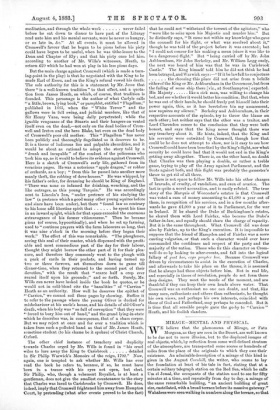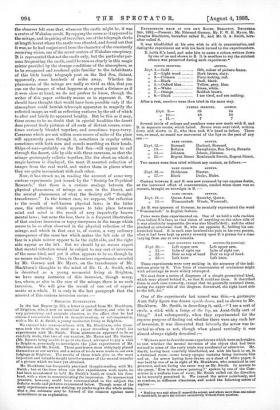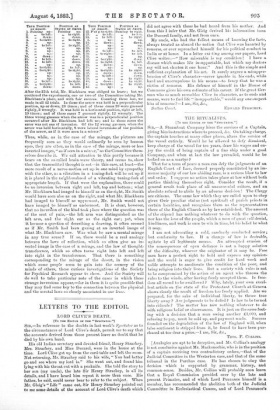MIRAGE—MENTAL AND PHYSICAL.
WE believe that the phenomena of Mirage, or Feta Morgans, as they are seen in the Desert, are well known to be due not to mere illusion, but to the displaced images of real objects, which, by reflection from some well-defined stratum of the atmosphere, are transported some scores or hundreds of miles from the place of the originals to which they owe their existence. An admirable description of a mirage of this kind is given in the August Cornhill, the writer, who seems to lay the foundation at least of his tale in fact, stating that at a certain solitary telegraph station on the Red Sea, which he calls Um el Jemal, the occupants of the station used to see for fifty minutes at a time, and repeatedly from day to day, a mirage of the same remarkable building, " an ancient building of great size, castellated, with a broad terrace before its massive gateway." Wahabees were seen walking in numbers along the terrace, so that the observer felt sure that, wherever the castle might be, it was a centre of Wahabee revolt. Bycopying the scene as it appeared in the mirage, and inquiring of travellers, one of the telegraph clerks
at length learnt where the castle was situated, and found out that it was, as he had conjectured from the character of the constantly recurring vision, one of the secret centres of Wahabee conspiracy. It is represented that not the castle only, bnt the particular per- sons frequenting the castle, could be seen so clearly in this magic mirror provided by the strange conditions of the atmosphere, as to be recognised and rendered quite familiar to the inhabitants
of this little lonely telegraph post on the Red Sea, distant, apparently, some hundreds of miles away. Whether the phenomena of the mirage are really so vivid as this, that you can see the images of what happens at so great a distance as if
it were close at hand, we do not profess to know, though the writer of this paper evidently means so to represent it. We should have thought that would have been possible only if the atmosphere could furnish telescopic apparatus to magnify the reflected image, as well as reflecting surfaces by the aid of which to alter and falsify its apparent locality. But be this as it may, there seems to be no doubt that in special localities the desert does present lively pictures of all sorts of distant scenes, some- times curiously blended together, and sometimes topsy-turvy.
Caravans which are not within some scores of miles of the place will apparently pass through it, sometimes in regular order, sometimes with both men and camels marching on their heads. Ships-of-war—probably on the Red Sea—will appear to sail through the desert, side by side with these caravans, so that the mirage grotesquely collects together, like the sheet on which a magic-lantern is displayed, the most ill assorted collection of images from the real world, and unites them in places where they are quite inconsistent with each other.
Now, it has struck us, in reading the account of some very
curious experiments just issued by the " Society for Psychical Research," that there is a curious analogy between the physical phenomena of mirage as seen in the Desert, and the mental phenomena of what the Society call " thought- transference." In the former case, we suppose, the reflection is the result of well-known physical laws ; in the latter case, the reflection which appears to take place between mind and mind is the result of very imperfectly known mental laws ; but none the less, there is a frequent illustration of that curious inversion or topsy-turvyness in the image which seems to be so often observed in the physical reflection of the mirage, and which in that case is, of course, a very ordinary consequence of the same law which makes the left side of the
face in a plain mirror appear to be the right side, and the right side appear as the left. But we should by no means expect that mental reflection would be subject to any sort of inversion of the same kind, and yet it often appears to be so, though by no means uniformly. Thus, in the curious experiments recorded
by Mr. Gurney and Mr. Myers, on the transference of Mr. Blackburn's thoughts to the mind of Mr. G. A. Smith, who
is described as a young mesmerist living at Brighton, we have many instances of this inversion, though many,
too, where, as also in the case of the mirage, there is no such inversion. We will give the record of one set of experi-
ments as a whole. It is only in the last paragraph that the account of this curious inversion occurs :—
" BRIGIT rOS EXPERIMENTS.
In the last Report (p. 63), a letter is quoted from Mr. Blackburn, of Brighton, who is now an associate of our Society, and who is a very painstaking and accurate observer, to the effect that he had obtained remarkable results in thought-reading, or will.impression, with a Mr. G. A. Smith, a young mesmerist living at Brighton.
We entered into correspondence with Mr. Blackburn, who there- upon took the trouble to send ns a paper recording in detail his experiments with Mr. Smith. These statements appeared to be so carefully made, that two of our number, Mr. Myers and Mr. Gurney (Mr. Barrett being unable to go at the time), arranged to pay a visit to Brighton, personally to investigate the joint experiments of Mr. Blackburn and Mr. Smith. These gentlemen most obligingly placed themselves at our service, and a series of trials were made in our own lodgings at Brighton. The results of these trials give ns the most important and valuable insight into the manner of the mental transfer of a picture which we have yet obtained.
Mr. Blackburn has frequently practised thought-reading with Mr. Smith ; but at the time when our first experiments wefe made, he had been accustomed to hold Mr. Smith's hand, or touch his fore- head, with a view to communicating the impression. No unconscious pressure, however, could have communicated to the subject the definite words and pictures enumerated below. Though some of the early experiments are not striking, we prefer to give the whole series, that a due estimate may be formed of the chances against more coincidence as an explanation.
EXPERIMENTS MADE AT OUR OWN ROOMS, BRIGHTON, DECEMBER San, 1882.—Present : Mr. Edmond Gurney, Mr. F. W. H. Myers, Mr. Douglas Blackburn, hereafter called B., and Mr. G. A. Smith, here- after called S.
S. was blindfolded at his own wish to aid in concentration, and during the experiment sat with his back turned to the experimenters.
B. holds S.'s hand, and asks him to name a colour, written down by one of us and shown to B. It is needless to say the strictest silence was preserved during each experiment.* OOLOIIR SELECTED.
Expt. 1.—Gold
ANSWER.
Gilt, colour of picture-frame.
„ 2.—Light wood ..... Dark brown, slaty.
„ 3.—Crimson Fiery-looking, red.
„ 4.—Black Dark, black.
„ 5.—Oxford blue Yellow, grey, blue.
„ 6.—White Green, white.
„
7.—Orange
Reddish brown.
„ 8.—Black I am tired, and see nothing.
After a rest, numbers were then tried in the same way.
NUMBER SELECTED. ANHWEI/.
Erpt. 9.—
35 34
,, 10.—
48 58
„ 11.—
7 7
Several trials of colours and numbers were now made with S. and B. in separate rooms, which failed. Names were next tried, written down and shown to B., who then took S.'s band as before. There was, as usual, no sound nor movement of the lips on the part of any one :—
NAME CHOSEN. ANSWER.
Expt. 12.- Barnard Harland, Barnard.
,, 13.- Bellaire Humphreys, Ben Nevis, Benaris.
„ 14.- Johnson Jobson, Johnson.
„ 15.— Regent Street Rembrandt Steeth, Regent Street.
Two names were then tried without any contact, as follows :—
NAME CHOSEN. ANSWER.
Expt. 16.— Hebb:mute Hunter.
„ 17.— Black Drake, Blake.
Contact between S. and B. was now resumed by our express desire, as the increased effort of concentration, needed when there was no- contact, brought on neuralgia in B. :—
NAME CHOSEN. ANSWER.
Erpt. 18.— Queen Anne Queechy, Queen.
„ 19.— Wissenschaft Wissie, Wissenaft.
As B. was ignorant of German, he mentally represented the word " Wissenschaft " in English fashion.
Pains were then experimented on. One of us held a sofa cushion close before S.'s face, so that vision of anything on the other side of it was absolutely impossible (ho was also blindfolded) ; and the other pinched or otherwise hurt B., who sat opposite S., holding his out- stretched hand. S. in each case localised the pain in his own persoa, after it had been kept up pretty severely upon B.'s person for a time varying from one to two minutes.
PAST RENDERED PAINFUL. ANSWER (by pointing).
Expt. 20.— Left upper arm Left upper arm.
„ 21.-- Lobe of right ear Lobe of right ear.
„ 22.— Hair on top of head Hair on top of head.
„ 23.— Left knee Left knee.
These experiments were very striking in the accuracy of the indi- cations given by S. This form of transmission of sensations might with advantage be more widely attempted.
We next drew a series of diagrams of a simple geometrical kind, which were placed behind S., so that B. could see them. S. described them in each case correctly, except that he generally reversed them, seeing the upper side of the diagram downward, the right hand side to the left, &c."
One of the experiments last named was this,—a grotesque Aunt Sally figure was drawn upside down, and so shown to Mr. Blackburn. Mr. Smith, in describing it, said,—" I see a sort of circle, a stick with a lamp at the top, an Aunt-Sally sort of thing." And subsequently, when they experimented for the express purpose of finding out whether there were any such law of inversion, it was discovered that laterally the arrow was in-
verted as often as not, though when placed vertically it was almost always rightly described :—
" We have now to describe some experiments which were undertaken to teat whether the mental inversion of the object that had been noticed in some of the early trials was accidental or otherwise. Mr. Smith, having been carefully blindfolded, sat with his back to us, in a darkened room—some heavy opaque curtains being between him and us. An arrow having been drawn on a sheet of white paper, it was held by one of us in sight of Mr. Blackburn, who remained in our presence, and sat facing the same way as Mr. Smith. In answer to the query, How is the arrow pointing ?' spoken by one of the Com- mittee in a uniform tone of voice, Mr. Smith called out the direction as he mentally perceived it. We turned the arrow noiselessly, and at random, in different directions, and noted the following series of replies:— • Nothing was said when El. named the colour, and where more than one colour is mentioned, he gave the colours successively without fresh question.
After the 37th trial, Mr. Blackburn was obliged to leave ; but we continued the experiments, one or two of the Committee taking Mr. Blackburn's place, and with fair success. Counting these last, we made in all 42 trials. In these the arrow was held in a perpendicular position, up or down, 23 times ; and of these cases 20 were guessed rightly, 3 wrongly. It was held in a horizontal position, right or left, 19 times ; and of these cases 7 guessed rightly. 12 wrongly. The three wrong guesses when the arrow was iu a perpendicular.position occarred after Mr. Blackburn had left us ; and in these cases the error was not one of inversion. Of the 12 wrong guesses, when the arrow was held horizontally, 8 were lateral inversions of the position of the arrow, as if it were seen in a mirror."
Thus, while, as in the case of the mirage, the pictures are frequently seen as they would ordinarily be seen by human eyes, they are often, as in the case of the mirage, more or less inverted images, " as if seen in a mirror," as the Committee them- selves describe it. We call attention to this partly because it bears on the so-called brain wave theory, and seems to.show that the transmitted thought is not-in this case, at least-the mere result of a nerve-motion set up in one mind by sympathy with the other, as a vibration in a tuning-fork will be set up if it is placed in the neighbourhood of a vibrating tuning-fork of appropriate length. If that were the explanation, there could be no inversion between right and left, top and bottom; what Mr. Blackburn had imaged to himself as on the right, Mr. Smith would have seen also as on the right, and what Mr. Blackburn had imaged to himself as upeormost, Mr. Smith would not nave imaged to himself as undermost. It is clear, however, that no inversion of the kind took place where the question was of the seat of pain,-the left arm was distinguished as the left arm, and the right ear as the right ear ; yet, when it became a question of describing a drawing, it often seemed as if Mr. Smith had been gazing at an inverted image of what Mr. Blackburn saw. Was what he saw a mental mirage in any true sense If so, there would be a real analogy between the laws of reflection, which so often give an in- verted image in the case of a mirage, and the law of thought- transference, which so often turns right into left and left into right in the transference. That there is something corresponding to the mirage of the desert, in the vision which some people seem to gain into the scenery of the minds of others, these curious investigations of the Society for Psychical Research appear to show. And the Society will do well to take particular note of the cases iu which these strange inversions appear,-for in them it is quite possible that they may find some key to the connection between the physical and the mental laws so closely associated in our lives.
Twin PoemOw or Miaow. 1. Pointing up : 2.to left : 3. ;', down : 4.to right: Z. :' zip: 6. ,. to left: 7. w up : 9. w up : 9.up : 10. .... down : .11. to loft: 12. „ to left: 13.„ up :
14. ,, to right :
15. „ to right : 16. w up: 17. „ up:
18. „ up:
19. to left : 20. ., to right :
21.PP down : Poarrioa AS STATED BY Sierra. Pointing up. „ to right. down. to right. up. to right. up. up. up. dow . down. down.
to liu.fPr. to right.
up. up. up. to right. to left. down. Tatra Posmoa or Aaaow. 22. Pnt'g. to right : M. „ to left : 24. „ to left : 5. „ up : 23. „ down :
27. OP up :
28. ,. up : 29.to left : „ 30. „ to right :
31. ap „ to right M. „ to right:
31. „ down : St. up : 16. ,, to right : 37. „ down : 38. „ to left 33. „ up : 40. „ down :
„ to right:
42. up :
POSITION AS STATED ET SMITH.
Pointiug to right. to lett. to right. up. down. up. U. to left. to left. up. d..wn. to left. down. up. to right. down. down. to right. to right. to right. up.
PP PP • 15 PP PP PP
OP PP PP OP




































 Previous page
Previous page